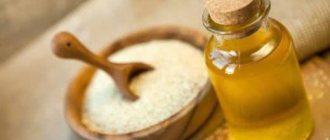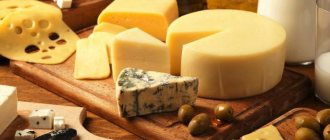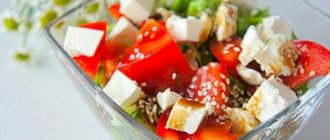Properties of feta cheese
Nutritional value and composition | Vitamins | Minerals
How much does feta cheese cost (average price for 1 kg)?
Moscow and Moscow region.
340 rub.
Traditional Greek feta cheese is made from sheep's milk, sometimes diluted with goat's milk. Interestingly, such cheese should be stored in brine and then the shelf life of the product is almost endless. To remove excess saltiness, feta cheese is soaked in milk or mineral water for a few minutes just before serving.
The word “feta” itself can be translated as “piece” or “chunk,” probably precisely because it is prepared in large pieces. Externally, feta cheese is white in color and resembles young cottage cheese in pressed form, but its taste is more salty, expressive, with a delicate lactic sourness. By the way, the aging time of this cheese should be at least three months. Depending on the fat content of the product, which varies from 30 to 60 percent, the calorie content of feta cheese also varies slightly, but on average it is 264 kcal.
This snow-white delicacy has been produced since the times of ancient Byzantium. Homer himself described the method of its preparation. In those days, containers with sheep's milk were taken out into the sun so that the liquid warmed up to about 35 degrees. After curdling the milk, the whey was drained, and the grounds were transferred to linen bags, which were hung for several days in reed baskets. The finished piece of feta cheese was cut into several pieces for further storage.
Currently, cheeses similar to feta are produced in the Mediterranean countries and throughout southeastern Europe, as well as in the Middle East. But they mainly use cow’s milk, which is why only a product from Greece can be called feta cheese. Quite often on the shelves you can find cheese called fetaki or fetax. This is practically the same feta cheese, the only difference is in the country of origin.
This product is not suitable for diets due to the rather high calorie content of feta cheese and considerable fat content, which often reaches 50 percent. If you really want it, you can afford only a small amount.
Feta cheese is an indispensable ingredient in the world-famous and beloved Greek salad, in which it is excellently combined with green lettuce, cucumber, tomato, sweet bell pepper, olives, onions and olive oil. You can treat yourself to this Greek cheese as a separate dish, flavoring it a little with fragrant fresh bread, sweet grapes or red wine. Feta cheese also goes well with various herbs: rosemary, oregano or mint. You can serve it with fish and other seafood, as well as meat. An excellent filling for pies, this dairy product is an integral part of the traditional Greek dish - feta and spinach pie.
Durum varieties
The solid product is widely represented in our stores - there is a large assortment of both domestic and imported varieties, but it is almost impossible to find a truly low-fat option among them.
It is relatively safe to consume only some solid varieties. First of all, it is worth mentioning Parmesan - many people know about this cheese. Its main advantage: a strong aroma and pronounced taste, so even a small pinch of crushed product radically improves any dish. You shouldn’t consume a lot of it - Parmesan contains a flavor enhancer, monosodium glutamate (it is formed naturally).
Swiss cheese can be considered relatively dietary (fat content is 45%). Domestic ones belong to this category:
- Soviet;
- Moscow;
- Altaic.
Hollandaise is also not very fatty - it is considered a perfectly acceptable option for breakfast, but it is better to eat it no more than once a week and in quantities of no more than 30 grams. The most famous domestic variety classified as the type under consideration is Kostromskaya.
The peculiarity of Cheddar is the presence of a salty taste and a slight sweetness. Its calorie content is relatively small, so, like the Dutch one, you can eat it a little once a week.
“Russian” can be considered solid. This type is very popular in our country, but it is often counterfeited, so read the label carefully before purchasing.
Some cheeses are additionally smoked. They are saltier, have a brownish crust and a characteristic aroma. In our trade we often encounter:
- Gouda with smoke;
- Cheddar;
- Gruyere.
The benefits of solid foods are undeniable - they contain a lot of amino acids and lecithin. The last substance is necessary for cells to strengthen membranes. Also it:
- helps reduce cholesterol levels;
- activates the production of enzymes that ensure the absorption of fats.
Sometimes low-fat cheeses need to be consumed not only to maintain a thin waist, but also for health reasons. Thus, therapeutic diet No. 5, used for diseases of the gallbladder and liver, also involves restriction in fatty foods (maximum 90 g of fat per day), and therefore there is a switch to low-fat cheeses in the diet. Ricotta and Adyghe cheese are perfect.
Here is a list of the most famous dietary cheeses.
Tofu (1.5-4%)
This cheese is made from soy milk and is considered curd cheese. Most of all it resembles feta cheese, but unsalted. It is impossible not to note the highest content of high-quality protein; tofu can replace meat and eggs in this regard. Calorie content – up to 90 kcal. Nutritionists note the healing properties of tofu, because this cheese helps lower “bad” cholesterol and prevents vascular diseases, osteoporosis, heart problems, etc.
Tofu contains phytoestrogens, so it is an ideal dish for women with hormonal imbalances, during menopause, etc. The only “but”: tofu can contribute to excessive gas formation.
Ricotta (2-24%)
True, this is not cheese, at least in our usual understanding, but rather cottage cheese. The consistency is like sandwich paste. Manufacturers often add sugar, even dried fruits, to ricotta, turning the dietary product into a curd mass. Therefore, it is important to ensure that the cheese is without these additives.
It is created from the leftover whey from other cheeses. Ricotta does not contain the usual milk proteins, there is only albumin protein, which is present in the human blood (the reason why the absorption of ricotta occurs many times faster and easier). Its calorie content is a maximum of 172 kcal.
Ricotta has a lower fat content - 8% - from cheeses made from cow's milk (from goat's milk - up to 24%). It contains a minimal amount of Na. This product is highly nutritious and quickly saturates the body. It also heals the nervous system, improves visual acuity, and normalizes the condition of hypertensive patients.
It is produced by introducing bacteria of fermented milk origin into already pasteurized milk. Similar in taste to its Italian counterparts. Adyghe cheese is an obligatory part of the diet of those losing weight, as well as those following diet No. 5. Because it contains no carbohydrates and as much as 19 g of protein.
Mozzarella (17-24%)
It cannot be called a source of necessary, beneficial bacteria, because the milk for such cheese is fermented using rennet enzymes; There is no provision for adding any additional microflora.
The base of the cheese is sheep's milk, the product is rich in calcium, beta-carotene, vitamins, and sodium. Stored in light brine. The product has a delicate taste, so it is allowed at table No. 5. Feta contains an abundance of beneficial lactic acid bacteria. Therefore, its use helps to cope with food poisoning; it is advisable to choose cheese with a fat content of 27%.
In essence, it is cottage cheese with low fat content. Some people in Russia call it Lithuanian cottage cheese or homemade cheese. And in Europe - rustic. Calorie content – only 85 kcal. The texture is soft, creamy, slightly salty.
Chechil (5-10%)
It is a product with a fibrous structure. Somewhat reminiscent of Suluguni. Usually created in the form of threads. Often sold already twisted into a pigtail. Chechil fibers are often picked up. It is not like any other cheese, it ripens in a special brine, sometimes it is mixed with other cheese, cottage cheese.
We suggest you read How to get rid of a scar on your face at home
Fitness cheeses
This is a special invention for those losing weight. Many manufacturers have such versions of cheeses today. By replacing fatty cheese in your usual home recipes with such an alternative, you can significantly reduce the calorie and fat content of your diet, which means you can lose weight faster. Now you don't have to choose between healthy teeth, hair and a thin waist. Let's list the most popular names.
- Gaudette (7%). It is semi-solid, has a subtle piquant taste, and has a high calcium content. This is an analogue of regular Gouda cheese, but low-fat.
- Viola Polar, Grünlander (5-10%), Fitness cheese. Excellent products for diet, sometimes containing 5% yogurt, which adds health benefits.
- Oltermani (16-17%) fat. It has a pleasant taste of milk, a dense and fairly uniform structure; a godsend for lovers of healthy eating.
- Dietary Ichalki (12.8%), Natura. It is considered a semi-hard variety, has a light yellow color and a distinct creamy taste. Can be stored for up to a week. Rich in Mg, K and a number of vitamins.
- Lakomo Light (20%). Made from cow's milk. Free from carbohydrates. Usually sold sliced.
Durum varieties are also perfect for the diet, albeit with reduced fat content. They may have a fairly high calorie content, but if you consume them in modest quantities, they will definitely not harm your figure. Such cheeses contain lecithin, which only improves our metabolism, stimulates the breakdown of fats, and at the same time normalizes cholesterol levels.
So, the following varieties can safely be classified as cheeses of this kind.
- Swiss (45%). It has a pronounced sweetish taste and has small eyes on the outside. Contains 380 calories.
- Parmesan (32%) is known for its specific smell, as well as a light aftertaste. Calorie content – 292.
- Dutch (45%). The product is yellow in color with a salty taste. Calorie content – 345 kcal.
- Cheddar. Often found in dietary form (33%). It has a nutty taste, sometimes slightly sour. Contains 380 kcal.
- Russian (50%). It has a creamy and slightly sweet taste. It has 360 calories.
Soft
Soft cheeses
The softest types of product are the least greasy. Of these, the curd variety is considered the best choice for dietary nutrition. This cheese does not require aging, and therefore it is easy to prepare at home.
French Brie and Camembert also belong to soft products. Their sign is a white mold crust. Both are quite high in calories, so they are not very suitable for diet.
Smolensky is quite acceptable, it is light and relatively non-greasy. The variety is analogous to Zakusochny and Okhotnichy.
Relevant products in the Online store:
Natura Siberica
COPENHAGEN Vitamin hair balm Frosty berries
349 rub.
sale
3LAB
Hydrating-Vita Cream Balancing anti-aging facial moisturizer
RUB 6,999
Rich
Reconstructive hair mask, moisturizing, giving healthy shine
from RUB 1,395
new exclusive
Retinol
Anti-aging sheet masks with collagen and vitamins B and E
699 rub.
exclusive
All goods
Feta cheese: benefits and harm, recipe with photos
Semi-hard white feta cheese has an unusual salty taste, but this is not its only feature. Let's figure out the benefits and harms of feta cheese.
Feta during pregnancy and breastfeeding
The product saturates the body with calcium, phosphorus and potassium. When carrying a child, it is definitely allowed, albeit in moderation. Harm can only occur if you have hypertension or kidney problems.
The same applies to using the product during lactation. You can introduce feta into your diet from the first days after birth. But at first you need to carefully monitor whether the baby develops allergies.
Is feta cheese good for weight loss?
The antioxidant properties of the product make it attractive for the diet. It will help cleanse the body of toxins and start the fat burning process. In addition, it contains few calories, and it is almost impossible to gain weight with small portions.
Recipe for making feta cheese at home
It will not be possible to replicate industrial manufacturing technology at home. But you can still make salted cheese in your kitchen, and the benefits will be considerable.
The ingredients you will need are the following:
- natural milk powder - 400 g,
- 600 ml warm drinking water,
- digestive enzyme abomin, which can be bought at the pharmacy (3 tablets),
- 100 g sour cream,
- a teaspoon of salt and half a teaspoon of vinegar.
- Milk must be thoroughly mixed with water, add sour cream and stir again.
- Then abomin, previously diluted with water, is poured into the mixture, vinegar and salt are added, and mixed again.
- The prepared mixture must be kept in a warm place for about 12 hours, and then the liquid whey must be drained through gauze folded several times.
- The remaining cheese mass should be wrapped in gauze and placed under a homemade press weighing about 3 kg.
- After 10 hours, the product will be ready - all you have to do is cut it into pieces and pour in brine.
The brine is made quite simply: add more salt to boiled water and let the water cool.
Attention! eat homemade feta cheese right away, but only after 1–2 weeks of aging in brine, otherwise the benefits will be less and the taste will be weaker.
How to eat feta
You can eat the delicacy separately, but it tastes much better when combined with other products:
- with vegetables and eggs - in salads, omelettes, scrambled eggs,
- in lavash - a healthy delicacy becomes an unusual filling,
- in baking - the properties of the product make the pies not only tasty, but also very healthy,
- with sandwiches.
The benefits of such dishes will be noticeably greater if you add feta to them.
The harm of feta cheese
No matter how great the benefits of the product, if used carelessly, you can harm your body. Some properties are dangerous even for completely healthy people.
- Saturated fats in large quantities are harmful to the heart system.
- The high salt content in the product can harm the kidneys, heart, blood vessels, provoke hypertension, and thicken the blood.
- Salt provokes thirst and retains fluid in the body.
It is recommended to eat no more than 75 g of the product per day - this dosage is safe.
Advice! To make feta as harmless as possible, it should be soaked in milk or mineral water before use. Valuable properties will be preserved, and salinity will decrease.
Fake feta, made from pasteurized milk with the addition of GMOs and antibiotics, can also cause harm to the body. Healthy cheese is only natural.
Who Shouldn't Eat Feta
Greek cheese also has several strict contraindications:
- angina and ischemia,
- arthritis,
- chronic severe diseases of the intestines, stomach and kidneys,
- type II diabetes,
- tendency to obesity.
Of course, it is better not to try milk cheese for those who are allergic to products containing lactose.
What is the difference between feta and cheese
Greek cheese is often confused with feta cheese - and indeed, the products are similar in appearance and taste. However, their properties are completely different.
- Brynza is a hard cheese, feta has a soft consistency.
- The most beneficial properties of feta are its high content of protein, calcium and vitamin A. Feta cheese contains a high concentration of potassium, sodium and sulfur.
- Feta is produced in Greece, feta cheese is produced in Romania.
- Greek cheese should be white, Romanian cheese may have a yellow tint.
- Feta is stored exclusively in a salt solution; feta cheese can be kept in the refrigerator on a plate.
How to choose and store correctly
Choosing healthy feta cheese is not difficult: you only need to know a few rules.
- Real cheese is of Greek origin. And the packaging always says “feta cheese” and not “cheese product”.
- High-quality cheese should be white. If a distinct yellowness is noticeable, then most likely it was stored incorrectly.
- The texture of feta is loose and crumbly, similar to cottage cheese.
- The composition of a good cheese is completely natural, without unnecessary additives, and the main ingredient is sheep or goat milk.
The product should be stored exclusively in the refrigerator. At the same time, healthy cheese retains its properties only in brine - the liquid cannot be poured out of the container. The maximum shelf life is 3 days - after which the use of the product will become dangerous.
The benefits and harms of feta cheese are determined primarily by the amount of consumption. In too large quantities, the salty product is dangerous, in small quantities it will have a beneficial effect on the body in the absence of contraindications.
Did you find this article useful? Not really








